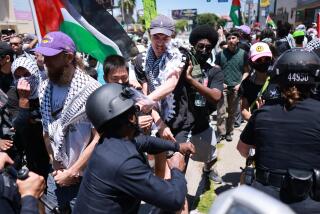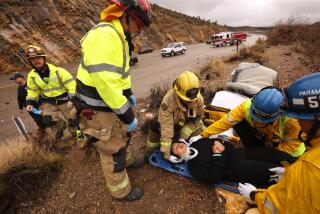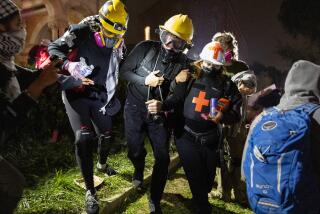KING CASE AFTERMATH: A CITY IN CRISIS : Hospitals Practice Battlefield Medicine in Caring for Stream of Violence Victims
Hospitals in Los Angeles showed the strain Friday of more than 48 hours of unremitting street violence as supplies ran low and fatigue overtook medical staff tending to more than 1,800 people injured in the mayhem.
At the hard-hit hospitals nearest the violence, âthey are practicing battlefield medicine, and they are completely exhausted,â said David Langness, spokesman for the Hospital Council of Southern California.
By late Friday the stream of injured had slowed considerably, officials said. But many hospitals reported being inundated with sick people who were isolated or too frightened by the disturbances to show up for scheduled admissions or surgery earlier in the week.
Transportation problems due to impassable streets, fires and violence interfered with supply deliveries to some hospitals. Los Angeles police officers had to ferry blood to Martin Luther King Jr./Drew Medical Center in Watts on Thursday because Red Cross trucks could not get through.
About 83 hospitals from all areas of Los Angeles reported treating people since Wednesday night for riot-related injuries, including bullet and knife wounds, cuts from glass shards and broken bones.
Los Angeles County-USC Medical Center in Boyle Heights dedicated five operating rooms around the clock to riot victims, spokesman Harvey Kern said. Sixty of the injured were brought to the hospitalâs emergency room between 9 a.m. Thursday and 8 a.m. Friday. Of these, two died in surgery after suffering gunshot wounds and nine remained in critical condition Friday.
The patients streamed in on their own or with the help of passersby.
Antonio Gaiton, 21, severely wounded by gunfire, was dumped by two companions from a bullet-riddled car Thursday at the entrance to County-USCâs General Hospital.
Security police rushed to help Gaiton to the emergency room, then arrested Gaitonâs companions, Jose Pineda, 25, and Juan Guebara, 26, on suspicion of looting, hospital officials said.
Gaiton subsequently died in the operating room, Kern said. Pineda and Guebara were turned over to the Los Angeles police.
As of 9:30 p.m. Friday, 1,869 people found their way to hospitals in Los Angeles County with injuries suffered in the violent aftermath of the Rodney G. King verdict, according to Peggy Stoker of the county health departmentâs Emergency Operations Center.
Twenty of these people died in the hospitals of their injuries, about half the total of riot-related fatalities logged by the county coronerâs office. Another 189 suffered critical injuries and 1,660 were classified as non-critical patients, according to Stoker.
Hospitals nearest the violence were the hardest hit. Besides County-USC and King/Drew, these included St. Francis Medical Center in Lynwood, California Medical Center downtown, Daniel Freeman Memorial Hospital in Inglewood and Huntington Memorial Hospital in Pasadena.
Among the patients treated in the emergency room at Daniel Freeman on Friday morning were three Los Angeles police officers who had suffered minor wounds from gunfire. There was also a black man on crutches whose head was thickly bandaged, a gray-haired white man trying to stem the flow of blood from a broken nose and a boy who had been hurt while trying to clean up a damaged store.
Then an ambulance arrived with another young boy who had been struck by a car. âIt looked like heâd been burned, his abrasions were so bad,â said charge nurse Joan Helton.
Traffic continued to arrive after nightfall, including one man who had been shot in the buttocks and another gunshot victim who was dead on arrival. It wasnât immediately clear whether the fatality was due to the mayhem.
But Friday seemed slow compared with the first night of misery, nurses agreed.
Under normal circumstances, the Daniel Freeman emergency room has space for 15 patients. On Wednesday night and early Thursday morning, âwe had 20 to 30 patients in here at one time, plus another 20 or 30 in the lobby,â said Kim Connelli, the emergency room director. On gurneys in a walkway were two gunshot victims and one boy who was hit by a car and was carried in on an ironing board by his family.
âWednesday night was the worst thing Iâve ever seen in my 15 years,â Connelli said.
Nurse Valerie Newfield had started her shift at 7:30 Wednesday morning and was about to head home when suddenly the emergency room was inundated with riot victims. âBefore we knew it, it was just mayhem,â Newfield said.
The nurse finally headed for home at 5:30 a.m. Thursday, ending a shift that lasted 22 1/2 hours.
âI started getting tired, but as long as I kept busy it was OK,â she said. The needs of others werenât the only compelling reason for her to stay so late, she noted. âI didnât want to leave in the middle of the night either.â
Among the 20 riot victims admitted to Daniel Freeman was Reginald Denny, the truck driver who became a symbol of the rioting after media helicopters videotaped a small mob dragging him from his truck and beating him senseless Wednesday evening. Donations have poured into the hospital to provide aid for Denny and other riot victims.
Dr. Leslie Geiger, a neurosurgeon, said Friday that Denny remained sedated but appeared to be recovering following surgery to repair a skull fracture and remove a blood clot. âItâs much too early to sayâ whether Denny has suffered any permanent brain damage, Geiger said. Doctors are optimistic, though, that he will recover from an injury that is threatening his sight in one eye.
Despite the overload, none of the hospitals attempted to close their emergency rooms, according to Stoker--evidence, she said, of an extraordinary effort among public and private hospitals to respond to the crisis.
The efforts of individuals also pulled many of the hospitals through the crisis.
When California Medical Center ran low on antibiotics late Thursday, pharmacist Robert Gillies ventured into the night to get more from Glendale Memorial Hospital.
Many hospitals reported staff shortages Friday, particularly among nurses, laboratory technicians and other medical personnel, Langness of the Hospital Council said. As exhausted workers were being sent home, scheduled replacements called in saying they could not get to work because of violence in their neighborhoods or en route to the hospital.
James Riedel, assistant administrator of St. Maryâs Hospital in Long Beach, wasnât surprised. He counted seven storefronts burned out along 7th Street, his usual route to the hospital.
More to Read
Sign up for Essential California
The most important California stories and recommendations in your inbox every morning.
You may occasionally receive promotional content from the Los Angeles Times.










